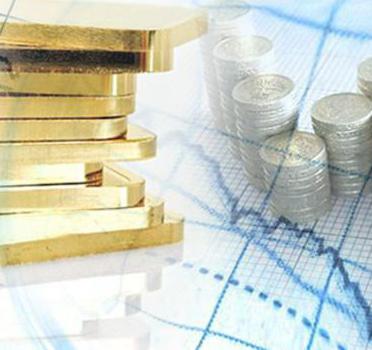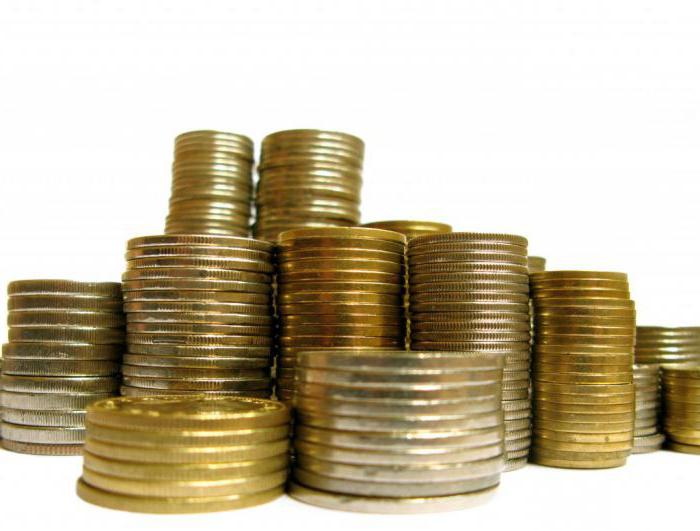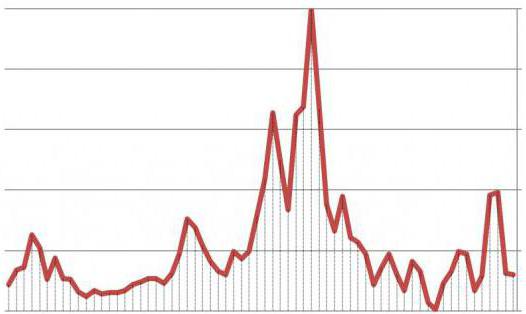Inflation indicators characterize the excess of money circulation over the money supply. This fact is manifested in rising prices for goods. Consider this indicator on the example of Russia. So, the inflation rate in Russia for 2014 amounted to 11.36%. And for 9 months of 2015 - 11.21%.
A bit of history
As an economic phenomenon, inflation indicators arose in the 20th century. 
However, periods of significant price increases existed earlier (for example, during one of the wars). The concept of "inflation" arose in the process of transition of monetary systems of a national scale to the circulation of paper money. Initially, inflation indicators in the economic sense contained the phenomenon of the presence of excess money in paper form, which leads to their depreciation and, consequently, an increase in prices for goods, work and services. The literal translation of the word "inflation" is "swelling."
The socio-political significance of inflation
The modern inflationary economy gives a slightly different, broader meaning. This is a peculiar consequence of a complex of factors confirming that inflation indicators reflect not only a monetary phenomenon, but also serve as a socio-economic and economic phenomenon. This economic indicator is closely interconnected with social psychology and public mood.
Prerequisites for the emergence of inflationary processes
Among the main prerequisites that contribute to the occurrence of inflation, it is necessary to highlight the following:
- price growth dynamics;
- an increase in government spending, which leads to an increase in the budget deficit.
An important indicator of the state of the economy of a state are macroeconomic indicators of inflation. It is known from history that the higher the level of these indicators, the worse for the whole society. Normal inflation rates are characterized by an increase in prices per year to 5%. With a coefficient approaching 100% (double the price increase), inflation is called galloping. If this indicator is thousands of percent, then this is hyperinflation.
Inflation measurement
This indicator is measured using a price index. Various methods can be used to calculate it, focusing on consumer prices, producer prices, or the GDP deflator.  The listed main indicators of inflation have a significant difference - a different structure of benefits is considered, which is included in the estimated set or basket. To calculate the price index, you need to take into account the value of the so-called market basket in the current one, as well as its value in the year taken as the base. Thus, the price index is the ratio of these two components.
The listed main indicators of inflation have a significant difference - a different structure of benefits is considered, which is included in the estimated set or basket. To calculate the price index, you need to take into account the value of the so-called market basket in the current one, as well as its value in the year taken as the base. Thus, the price index is the ratio of these two components.
When measuring inflation, other economic concepts must be taken into account. For example, in economic theory, terms such as nominal and real income are used quite widely. So, by nominal income is meant the actual income received by the business entity in the form of wages, interest and other profits. And real income is the amount of goods (services) actually purchased for the received amount of nominal income.
Types of Inflation
Types of this economic indicator depending on the speed (pace) of the course have already been mentioned above. In this case, we are talking about moderate (creeping), galloping (spasmodic) inflation, as well as hyperinflation.As for the latter phenomenon, in the presence of hyperinflation, production practically stops, the real volume of obtaining the national product decreases, unemployment rises, a large number of enterprises close, and bankruptcy often occurs.
However, there are other types of inflation. For example, depending on the nature of its manifestation:
- open inflation, in which there is a positive trend in rising prices for goods and services in conditions of free prices that are not regulated by the state;
- closed (suppressed), the occurrence of which is associated with an increase in the commodity deficit in the conditions of rather strict state control of prices.
Considering the economic indicators of inflation from the position of the reasons contributing to their occurrence, it is necessary to distinguish the following types:
- demand inflation;
- cost inflation;
- structural and institutional inflation.

For a complete analysis of inflation types, it is necessary to note the following:
- balanced inflation, in the event of which the prices of various goods change simultaneously and equally;
- unbalanced inflation associated with unequal growth in prices for goods, which leads to a violation in price proportions;
- expected inflation allows certain protective measures to be taken and is often calculated by the federal statistical authorities;
- imported inflation, which may occur under the influence of certain external factors.
Reasons for inflation
Among the causes of inflation, the following should be highlighted:
- monetary, caused by the mismatch of money demand and goods, when demand for them exceeds commodity circulation, there is an excess of income over expenses, there is a budget deficit, and the amount of investment may exceed economic opportunities;
- structural reasons arising in the presence of deformations in the national economic structure of the state, expressed in the lag in the development of certain industries, there is a decrease in efficiency in investment, which leads to deterrence of consumer ability;
- external reasons caused by a decrease in proceeds from trade, the presence of a negative balance of foreign trade balance.
Considering the causes of inflation from a different angle, we can note their following classification:
- Monetary factors represented by the unjustified issue of money by the state for their own short-term needs, as well as the repayment of the budget deficit due to the issue or through bank loans.
- A significant level of monopolization in the economy. Due to the fact that the monopoly is characterized by the presence of market power, therefore, it can influence the formation of prices. Monopolization can strengthen inflationary processes, which begin for other reasons.
- Militarization in the economy is associated with the absence of an increase in the state’s productive capacity with an increase in GDP due to arms production. Turning to history, it should be noted that too large military expenditures significantly hamper the country's economic development.
Conclusion
Summing up the material presented, it should be noted that inflation indicators in Russia are an integral part of the economic state of the state.








